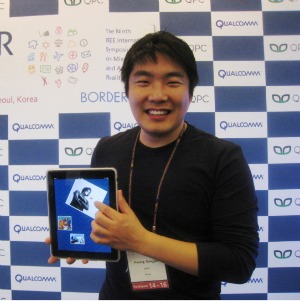One thumb not good enough for your smart phone? 28-year-old Sung Jae Hwang of KAIST’s Graduate School of Culture Technology developed a Virtual Thumb technology that overcomes the difficulties of using smart phone screens with one thumb.
Hwang noticed that mobile phones’ touch screens - though convenient - have their share of obstacles. One is that users tend to cover up their own phone screens with their fingers. Also, multi-touch functions such as zooming in and out are challenging when users have to hold the phone with the hand and control it with their thumbs at the same time.

This breakthrough technology gives the same effect as having two fingers to perform those functions: the Virtual Thumb corresponds to the point where the user’s thumb touches by imitating the physical touch. A point on the screen represents the movements by the Virtual Thumb and acts upon the orders of the actual thumb. It allows zooming in and out functions, as well as various rotation-based angle functions.
Moreover, in the case of unnecessary object rotation functions, this technology matches the changes in rotational angles subjectively. This allows for simultaneous commands by the user to be executed without having to acquire a separate menu. For a zoom-in command at a corner region, the corner can be zoomed in without shifting to the center of the screen.
Last December, the Virtual Thumb technology took the silver medal at the Korea Invention Patent Exhibition 2009 held by the Korean Intellectual Property Office. This invention is to be applied as a middleware on touch-based equipment and apparatus including television remote controls, eBooks, mobile phones, tablet PCs, navigation systems and educational devices.
“I am very honored that a small idea that evolved during research was developed into a commercialized technology,” said Hwang, the current president of the KAIST invention club, KAINVENTOR. “I will continue my studies to become a researcher who can contribute to the fields of academic research and industry in the future.”

